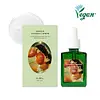What's inside
What's inside
 Key Ingredients
Key Ingredients

 Benefits
Benefits

 Ingredients Side-by-side
Ingredients Side-by-side

Water
Skin ConditioningPropanediol
SolventButylene Glycol
HumectantDiglycerin
HumectantGlycerin
Humectant1,2-Hexanediol
Skin ConditioningAscorbyl Glucoside
Antioxidant3-O-Ethyl Ascorbic Acid
Skin ConditioningPolysorbate 20
EmulsifyingSodium Citrate
BufferingXanthan Gum
EmulsifyingSodium Hydroxide
BufferingDipotassium Glycyrrhizate
HumectantNiacinamide
SmoothingMaltodextrin
AbsorbentCitric Acid
BufferingSucrose Dilaurate
EmollientSodium Cocoyl Glutamate
CleansingPisum Sativum Extract
Skin ConditioningWater, Propanediol, Butylene Glycol, Diglycerin, Glycerin, 1,2-Hexanediol, Ascorbyl Glucoside, 3-O-Ethyl Ascorbic Acid, Polysorbate 20, Sodium Citrate, Xanthan Gum, Sodium Hydroxide, Dipotassium Glycyrrhizate, Niacinamide, Maltodextrin, Citric Acid, Sucrose Dilaurate, Sodium Cocoyl Glutamate, Pisum Sativum Extract
Water
Skin ConditioningHippophae Rhamnoides Fruit Water
SolventNiacinamide
SmoothingPropanediol
Solvent1,2-Hexanediol
Skin ConditioningCamellia Sinensis Leaf Water
MaskingCaprylic/Capric Triglyceride
MaskingCastor Oil/Ipdi Copolymer
Acrylates/C10-30 Alkyl Acrylate Crosspolymer
Emulsion StabilisingTromethamine
BufferingXanthan Gum
Emulsifying3-O-Ethyl Ascorbic Acid
Skin ConditioningAdenosine
Skin ConditioningDisodium EDTA
Allantoin
Skin ConditioningBifida Ferment Filtrate
Skin ConditioningEthylhexylglycerin
Skin ConditioningButylene Glycol
HumectantMelaleuca Alternifolia Leaf Extract
PerfumingCaprylyl Glycol
EmollientWater, Hippophae Rhamnoides Fruit Water, Niacinamide, Propanediol, 1,2-Hexanediol, Camellia Sinensis Leaf Water, Caprylic/Capric Triglyceride, Castor Oil/Ipdi Copolymer, Acrylates/C10-30 Alkyl Acrylate Crosspolymer, Tromethamine, Xanthan Gum, 3-O-Ethyl Ascorbic Acid, Adenosine, Disodium EDTA, Allantoin, Bifida Ferment Filtrate, Ethylhexylglycerin, Butylene Glycol, Melaleuca Alternifolia Leaf Extract, Caprylyl Glycol
 Reviews
Reviews

Ingredients Explained
These ingredients are found in both products.
Ingredients higher up in an ingredient list are typically present in a larger amount.
1,2-Hexanediol is a synthetic liquid and another multi-functional powerhouse.
It is a:
- Humectant, drawing moisture into the skin
- Emollient, helping to soften skin
- Solvent, dispersing and stabilizing formulas
- Preservative booster, enhancing the antimicrobial activity of other preservatives
You might know this ingredient as Ethyl Ascorbic Acid, a more stable version of ascorbic acid.
Like other types of vitamin C, this ingredient has many benefits including reducing wrinkles, skin soothing, dark spot fading, and fighting against free radicals.
3-O-Ethyl Ascorbic Acid interferes with the process of skin darkening, helping to reduce hyperpigmentation. It also encourages the skin to produce more collagen.
Once applied, 3-O-Ethyl Ascorbic Acid is converted to Vitamin C deeper in the skin's layers. This process is slow but makes this ingredient more tolerable for skin.
The optimum pH range for this ingredient is 4 - 5.5
Learn more about 3-O-Ethyl Ascorbic AcidButylene Glycol (or BG) is used within cosmetic products for a few different reasons:
Overall, Butylene Glycol is a safe and well-rounded ingredient that works well with other ingredients.
Though this ingredient works well with most skin types, some people with sensitive skin may experience a reaction such as allergic rashes, closed comedones, or itchiness.
Learn more about Butylene GlycolNiacinamide is a multitasking form of vitamin B3 that strengthens the skin barrier, reduces pores and dark spots, regulates oil, and improves signs of aging.
And the best part? It's gentle and well-tolerated by most skin types, including sensitive and reactive skin.
You might have heard of "niacin flush", or the reddening of skin that causes itchiness. Niacinamide has not been found to cause this.
In very rare cases, some individuals may not be able to tolerate niacinamide at all or experience an allergic reaction to it.
If you are experiencing flaking, irritation, and dryness with this ingredient, be sure to double check all your products as this ingredient can be found in all categories of skincare.
When incorporating niacinamide into your routine, look out for concentration amounts. Typically, 5% niacinamide provides benefits such as fading dark spots. However, if you have sensitive skin, it is better to begin with a smaller concentration.
When you apply niacinamide to your skin, your body converts it into nicotinamide adenine dinucleotide (NAD). NAD is an essential coenzyme that is already found in your cells as "fuel" and powers countless biological processes.
In your skin, NAD helps repair cell damage, produce new healthy cells, support collagen production, strengthen the skin barrier, and fight environmental stressors (like UV and pollution).
Our natural NAD levels start to decline with age, leading to slower skin repair, visible aging, and a weaker skin barrier. By providing your skin niacinamide, you're recharging your skin's NAD levels. This leads to stronger, healthier, and younger looking skin.
Another name for vitamin B3 is nicotinamide. This vitamin is water-soluble and our bodies don't store it. We obtain Vitamin B3 from either food or skincare. Meat, fish, wheat, yeast, and leafy greens contain vitamin B3.
The type of niacinamide used in skincare is synthetically created.
Learn more about NiacinamidePropanediol is an all-star ingredient. It softens, hydrates, and smooths the skin.
It’s often used to:
Propanediol is not likely to cause sensitivity and considered safe to use. It is derived from corn or petroleum with a clear color and no scent.
Learn more about PropanediolWater. It's the most common cosmetic ingredient of all. You'll usually see it at the top of ingredient lists, meaning that it makes up the largest part of the product.
So why is it so popular? Water most often acts as a solvent - this means that it helps dissolve other ingredients into the formulation.
You'll also recognize water as that liquid we all need to stay alive. If you see this, drink a glass of water. Stay hydrated!
Learn more about WaterXanthan gum is used as a stabilizer and thickener within cosmetic products. It helps give products a sticky, thick feeling - preventing them from being too runny.
On the technical side of things, xanthan gum is a polysaccharide - a combination consisting of multiple sugar molecules bonded together.
Xanthan gum is a pretty common and great ingredient. It is a natural, non-toxic, non-irritating ingredient that is also commonly used in food products.
Learn more about Xanthan Gum